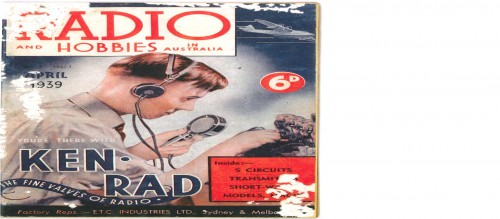
There are many Electron Tube suppliers still available today
Sets made before the early 1920s, when public broadcasting commenced, are rarely seen, so most "old" radios found were made between 1925 and the late 1960s. Listed here are some of the clues to dating old radios.
-
- 1920 - 1929
Radios of this period were mainly of the wooden "coffin" type with a hinged lid at the top and controls at the front, with any frequency indication being 0-100 markings on the large tuning knobs. Components were mounted on a wooden base board and the front panel, usually of black ebonite. Many were homemade and have no makers information. Bigger sets had several tuning stages, each with its own knob, which made them hard to tune.
- 1930 - 1934
During this period most radios were built into large well made wooden cabinets, often floor standing with access to the works from the back. Dials were small with 0-100 markings, with a single tuning knob and components attached to a metal removable chassis which contained the valves and large components on top, with the wiring and smaller parts underneath. Only the AM broadcast band was covered.
- 1935 - 1939
The later 1930s saw larger circular dials with a central pointer, often with stations marked, and sometimes with the addition of short wave bands. As well as wooden sets, some table or mantel cabinets were now made from attractive bakelite mouldings usually in a dark brown or cream colour. The chassis types were similar but with smaller components while 8-pin octal valves became standard over this period. Radiograms were introduced, remaining popular until the 1960s.
From 1934 until the 1960s nearly all Australian sets had a transfer, usually in blue, labelled ARTS&P on the back of the metal chassis to cover patent licensing. The letter preceding the serial number can give a guide to the year made. From 1934 to 1941 the letters A-F were used, with G-I, or no letter, being postwar.
- 1940 - 1949
Few domestic radios were made during WWII but radios of the late 1940s were often similar in size and style to the late 1930s. Miniature valves, introduced during the war, became available and were used initially in the manufacture of small bakelite portable sets. Mains sets now had On/Off switches, usually combined with the volume control.
- 1950 - 1959
This decade saw the full introduction of the miniature type of valve and plastic cases gradually replaced bakelite, allowing the introduction of brighter coloured sets. Car and portable radios also became more popular. Towards the end of the period, the first transistor sets came on to the market, usually as portables.
- 1960 - 1969
Australian radio manufacturing was superceded by imports towards the end of this period and solid state sets became universal. Station identification on dials fell out of use and FM bands were available on some imported receivers, though no such stations existed here until the 1970s. Size reduction meant that most receivers were plastic cased and portable by the end of the period. Radiograms were superceded by component stereo systems.
- 1920 - 1929
Post Your Ad Here
Comments